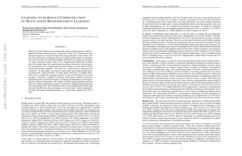GraphConnect: A Regularization Framework for Neural Networks
Deep neural networks have proved very successful in domains where large training sets are available, but when the number of training samples is small, their performance suffers from overfitting. Prior methods of reducing overfitting such as weight decay, Dropout and DropConnect are data-independent. This paper proposes a new method, GraphConnect, that is data-dependent, and is motivated by the observation that data of interest lie close to a manifold. The new method encourages the relationships between the learned decisions to resemble a graph representing the manifold structure. Essentially GraphConnect is designed to learn attributes that are present in data samples in contrast to weight decay, Dropout and DropConnect which are simply designed to make it more difficult to fit to random error or noise. Empirical Rademacher complexity is used to connect the generalization error of the neural network to spectral properties of the graph learned from the input data. This framework is used to show that GraphConnect is superior to weight decay. Experimental results on several benchmark datasets validate the theoretical analysis, and show that when the number of training samples is small, GraphConnect is able to significantly improve performance over weight decay.
PDF Abstract